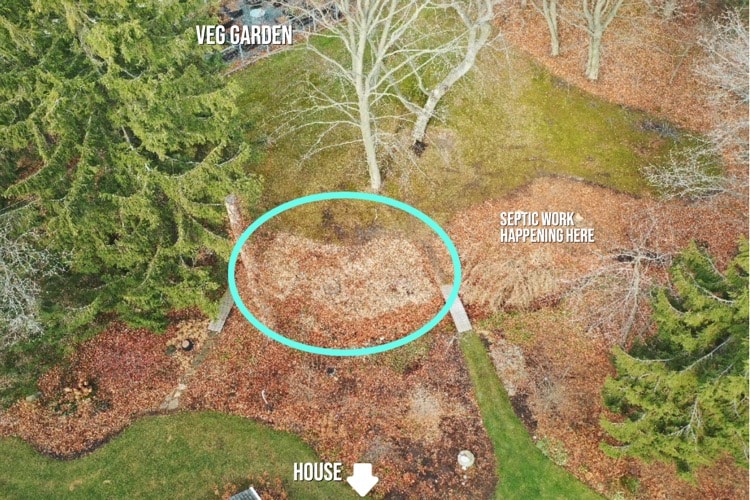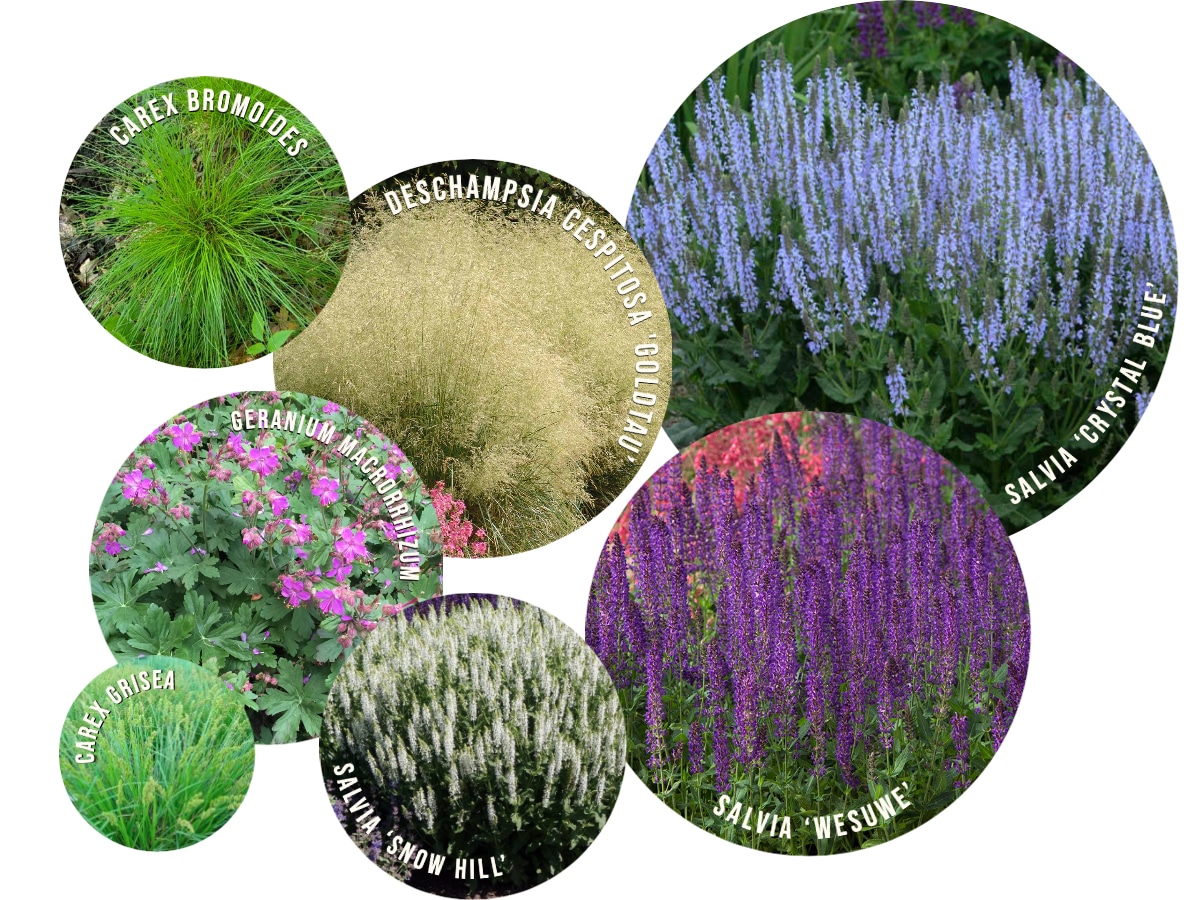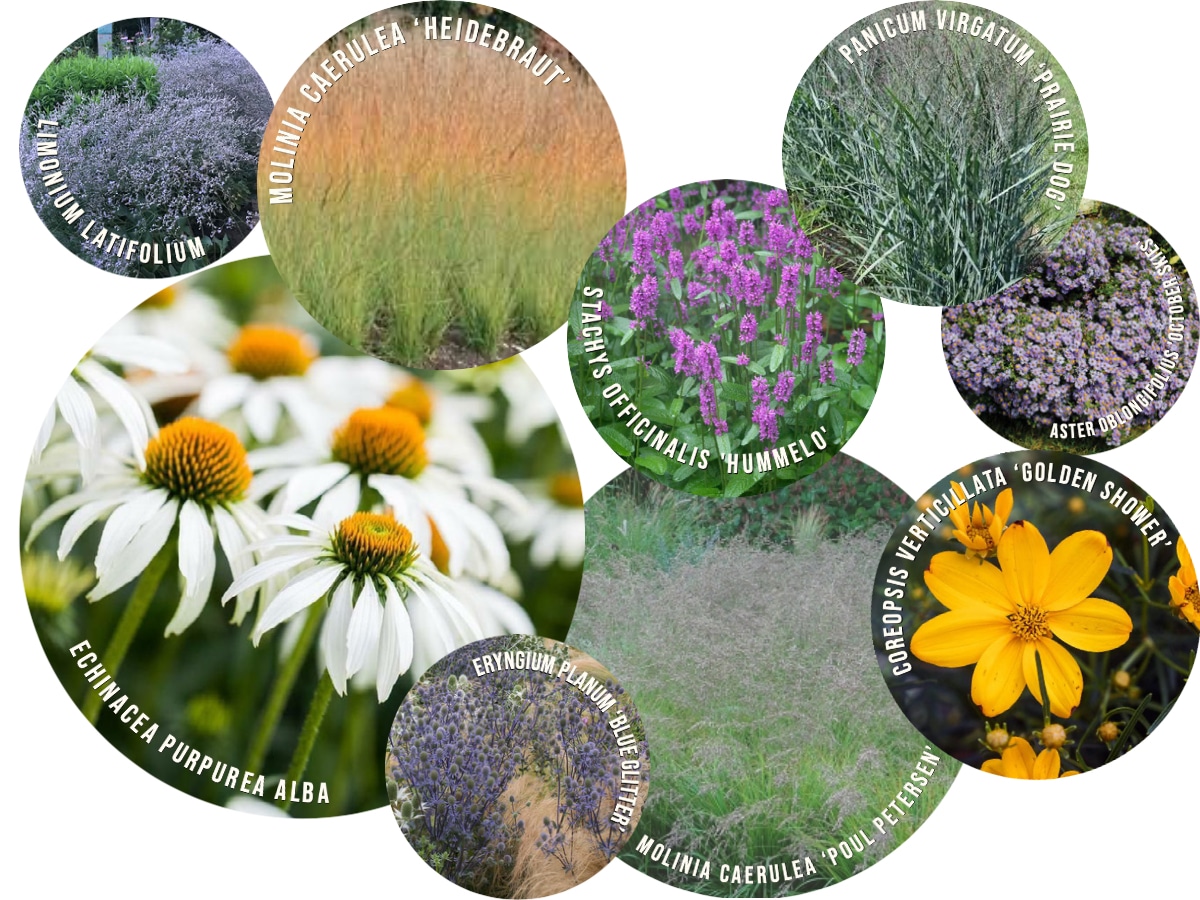There’s a well-established garden-making process around here: Every other year I make a new garden space. It is a lot of work, puts me behind in other areas of my arguably already too-large garden and takes a bit bite out of the plant budget. By the end of the project I swear I’m all done making new garden spaces and hold to that for a year. And then, almost like clockwork, the following year I end up making another garden.
In 2020 the big (and by big I mean the biggest garden space I’ve ever tackled) project was the new garden area along the road and driveway. That project (which I’m incredibly happy with even though there’s lot of tweaking to be done) was precipitated by the removal of an enormous ash tree that died from emerald ash borer infestation (along with most of the other ash trees in the area). With the new sun exposure it because a weedy mess, which wasn’t the entry to our property that I wanted.
Here in 2022 it’s a septic project that means there’s another area where some trees have been removed. Something will grow there, so my options are weeds (increasingly a range of invasive species) or something a bit prettier. I’m terrible about naming garden areas but I can assure you, I will not refer to this one as the “septic garden.”

What I like about this project is that I think it’s very typical for what a lot of homeowners might deal with. The space is approximately 30 feet by 15 feet, with a slope that leads to a “creek” where water runoff flows for much of the spring and early summer. Thanks to that tree removal, there’s a good amount of sun on the east end of it, and it gradually changes to a part-shade area on the west end. None of it has been planted (by humans anyway) but the soil is our usual sandy loam, with a fair amount of humus from years of falling leaves on it. Our soil tends to be fairly high pH, so acid-loving plants are typically a non-starter here because they require amending the soil annually.
This area is a bit farther from the house so deer pressure will be an issue.
I reached out to designer and plantsman (and my personal favorite descriptor: plant philosopher) Roy Diblik to team up on this project. Roy shares his design tips in his book The Know-Maintenance Perennial Garden and also on his YouTube channel, but I thought it might be helpful to work with him to employ those practices in a plan from start to finish so gardeners could see how to apply that knowledge in their own gardens.
He came for a site visit in mid-December (see that video here) and then a month later we met to talk through plants and plans. You can watch our whole design discussion here. More videos will follow all the way through planting and beyond.
The design is still being finalized but here are most of the plants that we’ll work to this area. In addition to these perennials, there are two Cornus alternifolia (pagoda dogwood) here (refugees from the driveway containers) and I may work in a handful of reseeding annuals this year or in the future.

- Salvia nemorosa ‘Crystal Blue’: Zone 3-8, 20″ tall x 24″ wide, sky blue flowers.
- Salvia nemorosa ‘Wesuwe’: Zone 3-8, 12-18″ x 24″ wide, violet-purple flowers.
- Salvia nemorosa ‘Snow Hill’: Zone 3-8, 18-24″ tall x 24″ wide, white flowers. This will be interspersed among other plants.
- Geranium macrorrhizum: Zone 4-8, 12″ tall, 24″ wide, amazing do-it-all ground cover. We’ll create a “river” of G. macrorrhizum in the garden to bridge the gap from a nearly garden and fill in under the dogwoods. I have a ton of ‘Bevan’s Variety’ available already in the yard for this area and I’ll mix in a few lighter colored varieties for interest.
- Deschampsia cespitosa ‘Gold Tau’: Zone 4-9, 12-16″ tall (2-3′ in flower), 24″ wide. It’s a beautiful, fluffy grass that wants moist soil. ‘Gold Tau’ is more resilient to occasionally dry soil so the plan is to plant this on the bank where rain will likely keep it moister.
- Carex bromoides: Zone 4-8, 8-12″ tall. Can tolerate being fully wet at times, so a good option for the bottom of the slope where the creek will occasionally rise to.
- Carex grisea: Zone 3-8, 20″ tall. Another sedge that appreciates moisture so a good one to plant in conjunction with C. bromoides.

- Molinia caerulea ‘Heidenbraut’: Zone 5-9, 12-18″ tall (3-4′ flowers), 24″ wide.
- Molina caerulea ‘Poul Petersen’: Zone 4-8, 12″ tall (24″ flowers”).
- Echinacea purpurea ‘Alba’: Zone 3-8, 18-24″ tall, 12-18″ wide.
- Limonium latifolium: Żonę 4-9, 18-30″, 12-18″ wide. This is one of those plants that I take note of every time I see it and I’m excited to finally be getting some in my garden.
- Stachys officinalis ‘Hummelo’: Zone 4-8, 18-24″ tall and wide, can push into part sun/shade areas.
- Coreopsis verticillata ‘Golden Showers’: Zone 4-9, 24-36″ tall, 18-24″ wide. This will be my first return to Coreopsis in more than a decade, after I had one go completely rogue in my garden. The yellow is needed in the design and I’m happy it’s part of the plan. It will be kept in check by Panicum ‘Prairie Dog’.
- Panicum virgatum ‘Prairie Dog’: Zone 4-9, 3-4′ tall, 2-3′ wide. Blue foliage.
- Aster oblongifolius ‘October Skies’: Zone 5-8, 15″ tall, 30″ wide. One of the few asters that is deer resistant. We’ll work this in here and there.
- Eryngium planum ‘Blue Glitter’: Zone 4-8, 36″ tall, 12″ wide. This will also be popped in amongst many of the plants in this section.
I have to say, I’m thrilled with this plant palette. It incorporates more varieties than I anticipated we’d be able to. And the process of working with Roy on this design was fascinating. I always say that I’m a gardener who dabbles in design, but I am not a trained garden designer, so I never know if the way I approach design is “right.” Of course there is no “right” way, but it was comforting to see that I start my design concepts the same way Roy does.
Of course there will be further tweaking of both the plant palette and the design. I hope you’ll come along for the ride.


25 Responses
I think your design will turn out beautifully. I also used Roy Diblik’s book for my garden. I planted repeated groupings of Agastache Blue Fortune, Agastache Little Adder, Butterfly Weed Tuberosa, May Night Salvia, Prairie Dropseed Grass, and Calamintha and the entire garden exploded in color the first year it was planted. He certainly knows how to create plant communities that work well together. The Stachys Hummelo is an awesome plant – it will look great with the combination of you chose. I can’t wait to see photos!
If you need a name for your new garden area that doesn’t include the word ‘septic’ – we’d suggest “The Fertile Field.”
Thank you for your great videos, and for introducing me to Roy Diblik. I am hoping to expand the border at the rear of my house, introducing more native plants and grasses. I love your plant selections, especially the salvias and grasses, but have been unable to locate Molina caerulea ‘Poul Petersen’, mail order . Can you help?
The plant selection and the area will bring you so much joy. Looking forward to watching it transform.
Absolutely following this garden as I have a similar project with similar interests. I am looking forward to watching your recent video with Roy Diblik on design. We are in zone 4b with acidic soil, and my garden is at a second home. Hardy plants that can hold there own once established is essential. Love your plant list as it has similar items we have discussed for ours. I need a name too! Right now it is the Piet Oudolf Meadow. Very intimidating name to live up to! One more difference. I am a very patient gardner. Too patient!
Remember Erma Bombeck? She had a book with the title “The Grass is Always Greener Over the Septic Tank.”
Watching you and Roy was very cool, especially as snow fell in Nashville. I’ve watched him elsewhere and feel more confident to using more natives and am expanding the garden into the septic field. Thanks especially for this blog with the detailed lists. AND am now reading Wendell Berry’s book.
I know the garden naming quandary well. Usually the name comes from what’s in the garden , i.e. vegetable garden or the garden’s location like the roadside garden. I have a garden unofficially dubbed the “piano garden” by my husband because of its shape, I’m not too keen on it. I would suggest something the larger public gardens do and name it after a contributor, so possibly the “Diblik Garden”?
My plan to dig a new garden space is exciting but prolly end me up in jail seeing that my neighbors prolly prefer i stay out of their property 🥴but my love of watching and waiting for new plants to go into ground and grow and develop will be lived through you and your channel . What fun you share with me and others and your knowledge is so broad. Continue on please ! Spring is dragging in West Virginia and probably for you as well! All great things are worth waiting 😊!
Hi Erin, My article did not have a link or other access to the site visit. How do I access it? Michael
Yes, I’ll definitely come along for the ride. Looking forward to seeing the transformation. We are 3 years in at our new home (formerly woods) in a very large lot. Mostly sunny areas. Tackling garden areas front, sides, and back. So I love seeing your projects. I actually planted some Stachys Hummelo this fall and am excited seeing the plant in your design. We’ll see how it does the thruout the year. Thanks for all your inspirations!
It sounds wonderful! Can’t wait to see the new garden!
I love reading the plant selections. I researching to see how they might work in my yard. I love your garden and am trying to copy you. More perennials and annuals… less (or no) mulch. Thanks for sharing.
Hi Erin ,Can’t wait to see it when it’s all done.It’s good that you seeked out help with this new garden .The plants are beautiful !!!
I sought out limonium after seeing it in Australia. Every time I walk past it in my garden it reminds me of that trip.
This sounds and looks like it’s going to be beautiful!
Very much looking forward to the journey 😀
Yes, the Septic Garden is a bit too …specific. How about the Overflow Garden? Overflowing with great plants and some good “compost” tea.😜 Between you and Roy, I have no doubt it will be something worth the effort!
About twenty years my septic garden was created in our front yard! The whole front yard was torn up. The contractors moved dirt around to level it as much as possible. When they were done I kept looking out the windows planning my move. I saw a circle for early spring bulbs and a herb garden, a pathway around it,a side bed for a cutting garden,and a bird feeder station on the other side.. I added a garden wall to hold my herb garden back from the road and planted spring bulbs and different daylilies. My bird bath is the centerpiece. Its a showstopper in different seasons. Can’t wait to see yours.
So wonderful to be able to keep expanding. I’m afraid I’d just keep going w Dahlia’s, Zinnia’s and Roses. Alas, I don’t have the space to get into “trouble” but it’s fun watching you do your magic.
Can’t wait to see this garden, it sounds great! I totally relate to your alternating years of major projects vs maintenance. I wonder if that’s common for gardeners? Something along the lines of women in labor saying they’ll never have another child?
We have extremely heavy deer pressure (up to 20 in my yard at a time), and lost several young trees to deer nibbling and/or rubbing. After trying several methods to protect their replacements, my favorite is to bend a 4′ x 16′ cattle panel into a circle around them and secure with wire or zipties. No t-posts or supports needed, they’re quite sturdy. When the tree is large enough, I remove the cattle panel and use elsewhere- usually as a trellis in my ever expanding veg garden. Not sure how large your dogwoods are, but though I’d share in case you’re worried about them.
I am looking forward to watching this new develop. I am intrigued by a few of these plants
I found the design process fascinating. How many total new plants are you planting? Will you grow any of the plants from seed and do you have a specific budget? Thank you for sharing!